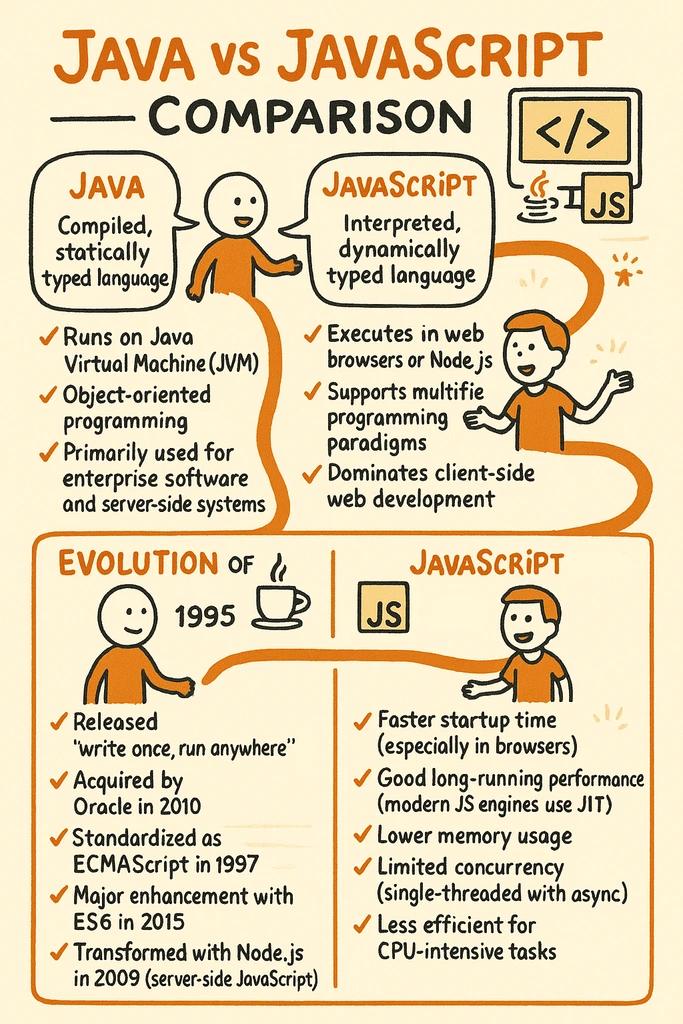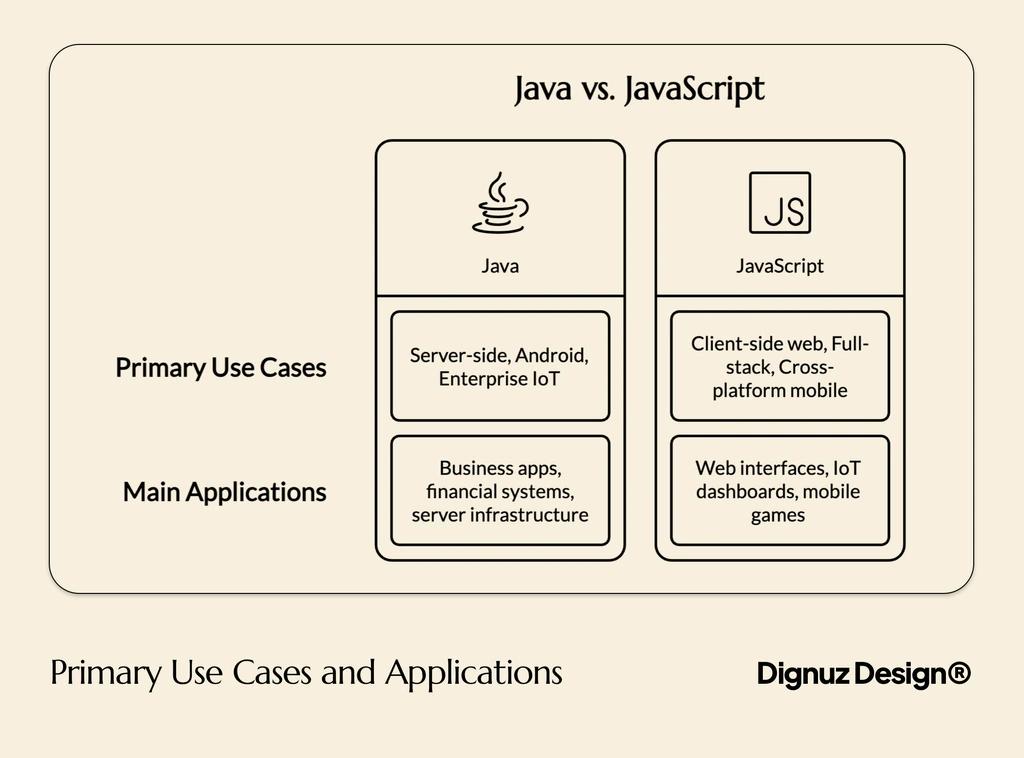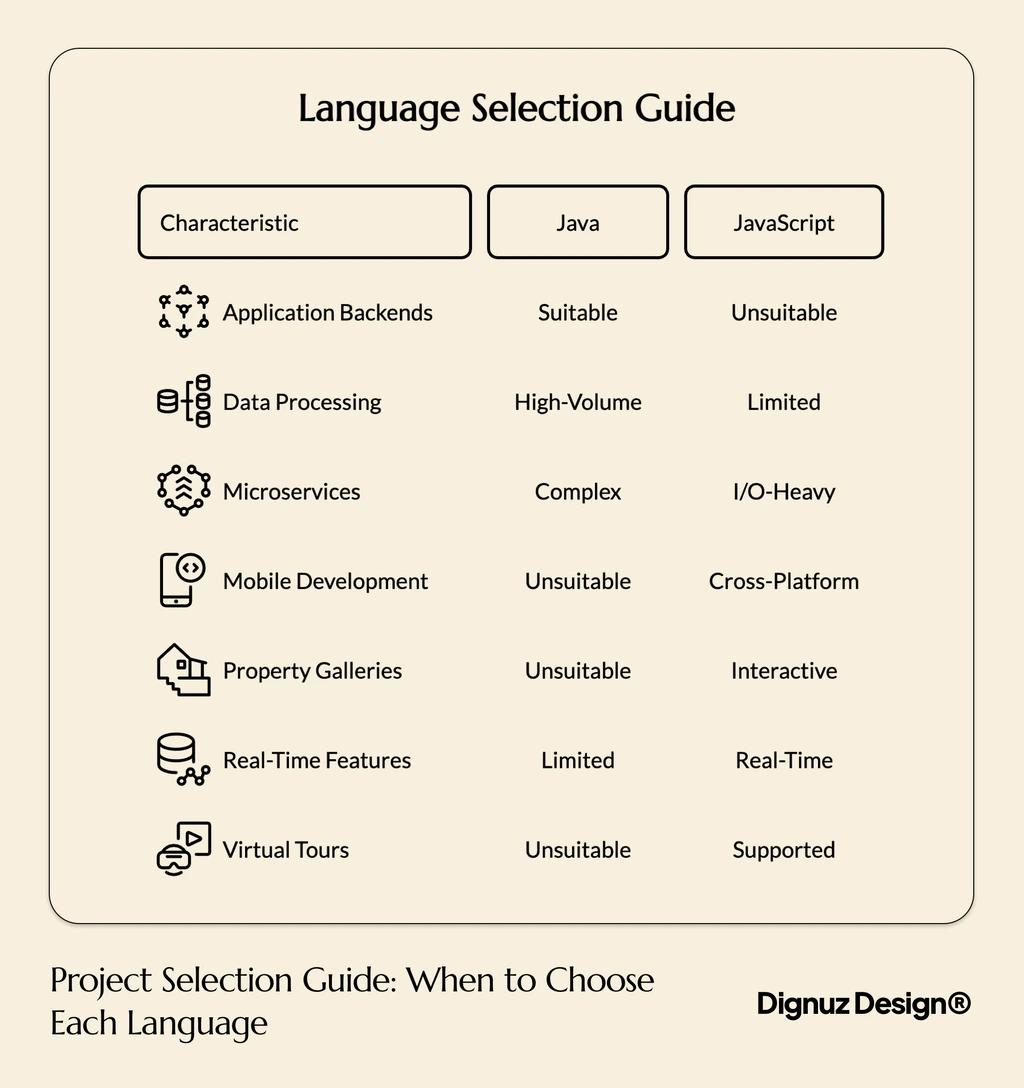Java vs JavaScript: Understanding the Key Differences

The names sound similar, but Java and JavaScript are two distinct programming languages with different uses and capabilities. This confusion often leads to misunderstandings among clients and developers alike. By understanding the fundamental differences between these languages, you can make better decisions about which technology suits your web development needs.
In this guide, we'll explore the key differences between Java and JavaScript, their unique strengths, and how each can benefit different types of web projects. This knowledge will help you communicate more effectively with development teams and make informed decisions about your website technology stack.
Origins and Evolution of Java and JavaScript
Despite their similar names, Java and JavaScript have entirely different origins. Java was created by James Gosling at Sun Microsystems (now owned by Oracle) in 1995. It was designed as a general-purpose programming language with an emphasis on security and portability across different platforms.
JavaScript, on the other hand, was created by Brendan Eich at Netscape in just ten days in 1995. The name similarity was actually a marketing decision, as JavaScript was originally called "Mocha" and later "LiveScript." Netscape changed the name to JavaScript to capitalize on Java's popularity at the time.
The two languages share almost nothing beyond some superficial syntax similarities. Their design philosophies, capabilities, and uses differ significantly. This fundamental difference has persisted through their evolution over the past 25+ years.
Key Historical Milestones
- Java: Released in 1995, introduced "write once, run anywhere" concept, acquired by Oracle in 2010
- JavaScript: Also released in 1995, standardized as ECMAScript in 1997, major enhancement with ES6 in 2015
- Java: Evolved through multiple versions (Java 8, 11, 17, etc.) with backward compatibility
- JavaScript: Transformed with the advent of Node.js in 2009, enabling server-side JavaScript
- Both: Developed huge ecosystems of frameworks, libraries, and development tools
Today, both languages have matured into robust platforms with distinct strengths. Their evolution continues to be shaped by different needs and use cases in the development world.

Language Type and Execution Model
One of the most fundamental differences between Java and JavaScript lies in how they're classified and executed. Java is a compiled, statically typed language that requires the Java Virtual Machine (JVM) to run. (Source: Statista)
In contrast, JavaScript is an interpreted, dynamically typed scripting language that traditionally executes directly in web browsers. (Source: Stack Overflow)
These fundamental differences affect everything from development workflow to performance characteristics. Let's break down these differences in more detail:
Language Type
- Java: Compiled
- JavaScript: Interpreted
Typing System
- Java: Static (types checked at compile time)
- JavaScript: Dynamic (types checked at runtime)
Compilation
- Java: Compiled to bytecode
- JavaScript: No compilation step
Runtime Environment
- Java: Requires JVM
- JavaScript: Browsers or Node.js
Memory Management
- Java: Automatic garbage collection
- JavaScript: Automatic garbage collection
This table highlights the core architectural differences between the two languages. These differences directly impact how developers write and deploy code in each language.
Static vs. Dynamic Typing
Java enforces static typing and strict syntax rules, which means variables must be declared with specific types. (Source: Statista)
Consider this simple Java code example where types must be explicitly declared:
String name = "John";
int age = 30;
boolean isActive = true;
JavaScript, however, uses dynamic typing with flexible syntax that allows variables to change types during execution. (Source: RedMonk)
The equivalent JavaScript code doesn't require type declarations:
let name = "John";
let age = 30;
let isActive = true;
// We can change types on the fly
age = "thirty"; // This is valid in JavaScript
This distinction impacts error detection, development speed, and code reliability. Java's static typing catches many errors at compile time, while JavaScript's dynamic typing offers flexibility but may allow certain errors to reach runtime.
Primary Use Cases and Applications
Java and JavaScript excel in different domains due to their distinct characteristics. Understanding these strengths helps developers and businesses choose the right tool for specific projects.
Java primarily powers enterprise software and server-side systems where reliability and scalability are crucial. (Source: RedMonk)
JavaScript dominates client-side web development and has expanded to server-side applications through Node.js. (Source: Stack Overflow)
Let's examine their primary application areas in more detail:
Web Development
- Java: Server-side applications, enterprise backends
- JavaScript: Client-side interactivity, full-stack with Node.js
Mobile Development
- Java: Android apps (native development)
- JavaScript: Cross-platform apps (React Native, Ionic)
Enterprise Solutions
- Java: Large-scale business applications, financial systems
- JavaScript: Modern web interfaces, real-time updates
IoT and Embedded
- Java: Enterprise IoT platforms, embedded systems
- JavaScript: Simple IoT interfaces, dashboard applications
Game Development
- Java: Server infrastructure, some Android games
- JavaScript: Browser-based games, simple mobile games
This table demonstrates how each language has carved out specific niches where its characteristics provide advantages. The concept of integrating various technologies with your web platform is crucial for creating comprehensive digital solutions that leverage the strengths of different programming languages.

Popular Frameworks and Libraries
- Java: Spring, Hibernate, Apache Struts, JavaServer Faces (JSF)
- JavaScript: React, Angular, Vue.js, Express.js, Next.js
- Java: Jakarta EE, Micronaut, Quarkus, Vert.x
- JavaScript: jQuery, D3.js, Three.js, Electron
The diversity of frameworks in both ecosystems reflects their versatility and the wide range of problems they can solve. Many modern web applications use JavaScript frameworks for the front end while using Java for complex backend operations that require robust performance and reliability.
Syntax and Coding Differences
While Java and JavaScript share some superficial syntax similarities (like the use of curly braces and semicolons), their coding paradigms and approaches differ substantially.
Java focuses on object-oriented programming (OOP) with explicit class definitions and strong typing. Everything in Java exists within classes, and the language enforces strict structural rules. This creates verbose but clear and maintainable code.
JavaScript supports multiple programming paradigms, including object-oriented, functional, and procedural styles. This flexibility allows developers to choose their preferred approach, but it can also lead to inconsistent coding styles across projects.
Main Syntax Differences
- Class Declaration: Java requires explicit class definitions; JavaScript has multiple ways to create objects
- Type Declarations: Java requires explicit types; JavaScript uses dynamic typing
- Function Definitions: Java methods must be inside classes; JavaScript functions can exist independently
- Inheritance: Java uses classical inheritance; JavaScript traditionally uses prototypal inheritance
- Error Handling: Java uses checked exceptions; JavaScript uses simpler try/catch mechanisms
Java errors are typically caught during compilation, preventing many issues before the code runs. (Source: Statista)
JavaScript errors usually appear at runtime when the code executes, which can lead to unexpected behavior if not properly tested. (Source: Stack Overflow)
Here's a simple example comparing how to create a class and object in both languages:
Enhanced Web Experience
Discover how AmplyViewer can transform real estate project presentations with interactive 3D visualization.
Learning Curve Comparison
The learning curves for these languages differ substantially based on their design philosophies and complexity. Learning either language requires time and dedication, but they present different challenges.
Initial Entry Barrier
- Java: Higher (requires understanding OOP concepts)
- JavaScript: Lower (can start with simple scripts)
Syntax Complexity
- Java: More verbose and rigid
- JavaScript: More flexible but with quirks
Debugging
- Java: Easier (compiler catches many errors)
- JavaScript: More challenging (runtime errors)
Environment Setup
- Java: More complex (JDK, IDE configuration)
- JavaScript: Simpler (just a browser or Node.js)
Advanced Concepts
- Java: Threads, generics, reflection
- JavaScript: Asynchronous programming, closures, prototypes
This comparison highlights how each language presents different challenges for new learners. JavaScript might be easier to start with, but mastering its nuances and avoiding common pitfalls can be challenging. Java has a steeper initial learning curve but provides more guardrails through its strict typing and compilation.
Execution Environments and Performance
The execution environment of a programming language significantly affects its performance characteristics and use cases. Java and JavaScript operate in fundamentally different environments.
Java runs on the Java Virtual Machine (JVM), which provides a layer of abstraction between the compiled Java bytecode and the underlying operating system. (Source: Visual Capitalist)
JavaScript traditionally executes in web browsers through JavaScript engines like V8 (Chrome), SpiderMonkey (Firefox), or JavaScriptCore (Safari). With Node.js, JavaScript can also run on servers outside the browser environment. (Source: Visual Capitalist)
Platform Dependencies
Java applications require JVM installations on the host system, but once installed, they can run consistently across different platforms. (Source: Statista)
JavaScript runs natively in modern web browsers without additional installations, making it immediately accessible to users. (Source: Stack Overflow)
These differences in execution environment affect deployment, performance, and user experience. Let's examine the performance implications in more detail:
Startup Time
- Java: Slower (JVM initialization)
- JavaScript: Faster (especially in browsers)
Long-Running Performance
- Java: Excellent (JIT compilation)
- JavaScript: Good (modern JS engines use JIT)
Memory Usage
- Java: Higher baseline (JVM overhead)
- JavaScript: Lower baseline
Concurrency
- Java: Excellent (multi-threading)
- JavaScript: Limited (single-threaded with async)
CPU-Intensive Tasks
- Java: Better performance
- JavaScript: Less efficient
This performance comparison explains why Java remains popular for enterprise applications and systems that require high throughput and concurrent processing, while JavaScript excels at providing responsive user interfaces and handling I/O-bound operations efficiently.
Popularity and Industry Adoption
Both Java and JavaScript maintain strong positions in the programming language ecosystem, though their popularity trends differ based on industry needs and technological shifts.
JavaScript ranked #1 in the 2024 Stack Overflow Developer Survey, highlighting its dominance in web development and increasing role in other domains. (Source: Stack Overflow)
Java held 3rd place in RedMonk's 2024 programming language rankings, demonstrating its continued relevance in enterprise software development. (Source: RedMonk)
These popularity metrics reflect the different niches these languages occupy in the technology landscape. Let's look at the trends and job market implications:
Developer Popularity (2024)
- Java: 3rd place (RedMonk)
- JavaScript: 1st place (Stack Overflow)
Job Market Demand
- Java: Strong (enterprise, Android)
- JavaScript: Very high (web, full-stack)
Industry Sectors
- Java: Finance, enterprise, Android, big data
- JavaScript: Web development, startups, front-end
Community Size
- Java: Large, established
- JavaScript: Very large, diverse
Growth Trend
- Java: Stable
- JavaScript: Growing
This popularity comparison shows that both languages remain highly relevant, with JavaScript seeing more growth in recent years due to the expansion of web technologies and Node.js adoption. Java maintains its strong position in enterprise environments where its stability and performance characteristics are valued.

When to Choose Java vs JavaScript for Your Web Projects
Selecting the right programming language for your web project depends on several factors, including project requirements, team expertise, and long-term maintenance considerations. Here's guidance on when each language might be the better choice:
Factors to Consider When Choosing
- Project Type: Front-end interactivity vs. backend processing
- Performance Needs: CPU-intensive operations vs. I/O operations
- Team Expertise: Available developer skills and experience
- Scalability Requirements: Expected growth and concurrent user handling
- Integration Needs: Compatibility with existing systems
With custom websites outperforming template solutions for real estate professionals, choosing the right technology stack becomes even more critical for creating distinctive online experiences.
The table below provides guidance on which language might be more suitable for different project types:
Interactive Website Frontend
- Better Choice: JavaScript
- Reasoning: Native browser support, rich UI libraries
Enterprise Application Backend
- Better Choice: Java
- Reasoning: Robust performance, strong typing, security
Real-time Web Application
- Better Choice: JavaScript (Node.js)
- Reasoning: Event-driven architecture, WebSockets support
High-volume Data Processing
- Better Choice: Java
- Reasoning: Multi-threading, memory management, optimization
Microservices Architecture
- Better Choice: Both (depends on service)
- Reasoning: Java for complex services, Node.js for I/O-heavy services
In many modern web applications, a combination of both languages delivers the best results. JavaScript handles the front-end interactivity and user experience, while Java powers complex backend processes that require high performance and reliability.
Modern Development Approaches
Many development teams today adopt a polyglot approach, using different languages for different parts of their system. For web applications, this often means:
- JavaScript/TypeScript with React, Vue, or Angular for the frontend
- Java with Spring Boot or similar framework for complex backend services
- Node.js for lightweight microservices or real-time features
Is Webflow easy to use for web development projects that require custom code integration? The answer depends on your specific needs and technical expertise. Webflow provides a visual interface that can be extended with custom JavaScript, making it accessible for many real estate websites.
How These Languages Impact Web Development for Real Estate
In the context of real estate web development, understanding the strengths of Java and JavaScript helps in creating more effective digital experiences for property listings, virtual tours, and client management systems.
Real estate websites often need to balance visual appeal with functional capabilities. JavaScript excels at creating interactive property galleries, map integrations, and filtering systems that enhance the property search experience. Java might power backend systems that handle large property databases, user authentication, or complex search algorithms.
Real Estate Web Development Applications
- JavaScript: Interactive property galleries, real-time map integrations, virtual tours
- Java: Property database management, secure transaction processing, analytics
- JavaScript: Real-time alerts for new listings, chat functionality for client communication
- Java: CRM systems, document processing, automated reporting
- Both: Property matching algorithms, personalized recommendation engines
When building custom websites using Webflow for web development, you can leverage JavaScript to enhance the user experience without requiring extensive coding knowledge. This approach allows real estate professionals to maintain modern, interactive websites that showcase properties effectively.
For real estate applications with complex requirements, a hybrid approach often works best. The frontend user experience benefits from JavaScript's interactivity, while Java can power robust backend systems that handle data processing, security, and integration with other business systems.
Conclusion
Java and JavaScript, despite their similar names, serve different purposes in the programming world. Their fundamental differences in design, execution, and application make them complementary tools rather than competitors.
Java's compiled nature, static typing, and robust performance make it ideal for enterprise applications, large-scale systems, and scenarios requiring maximum reliability and scalability. JavaScript's flexibility, browser integration, and evolving ecosystem make it perfect for creating interactive web experiences and increasingly capable backend services.
For real estate web development, understanding these distinctions helps in making better technology choices. Many successful projects leverage both languages: JavaScript for creating engaging user interfaces that showcase properties effectively, and Java for building reliable backend systems that manage data and transactions securely.
Whether you're developing a new real estate website or upgrading an existing one, consider how these languages might fit into your technology stack. The right combination can create powerful, scalable digital experiences that help your property listings stand out in a competitive market.
Ready to enhance your real estate web presence with the right technology choices? Contact our team to discuss how we can help you create a custom web solution that combines beautiful design with powerful functionality.



